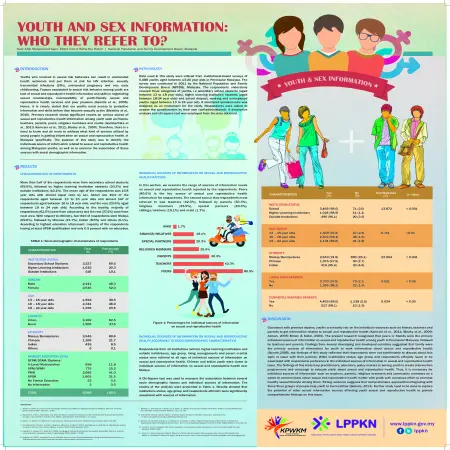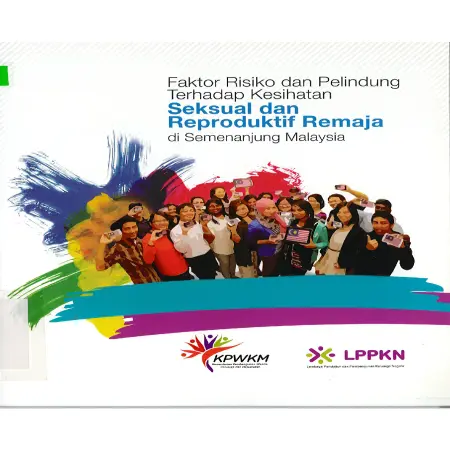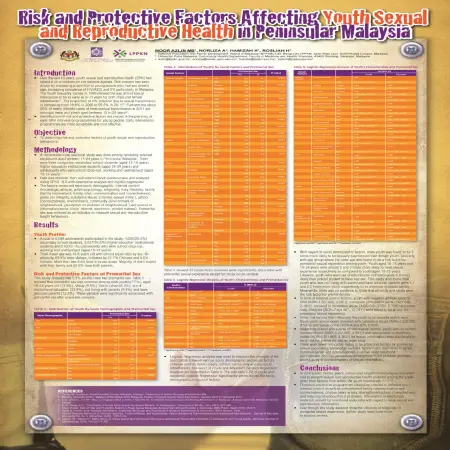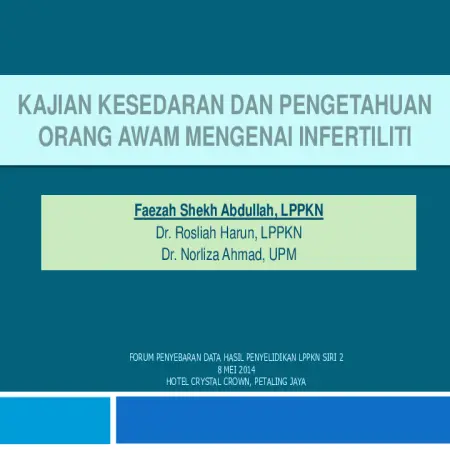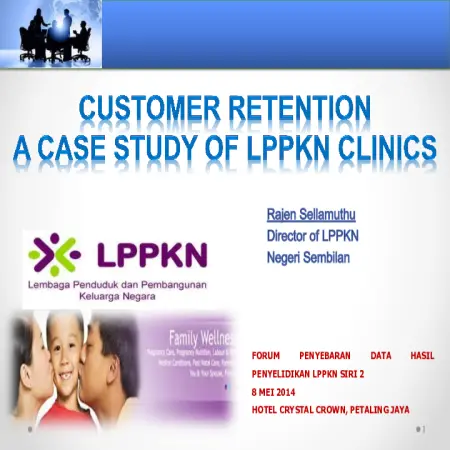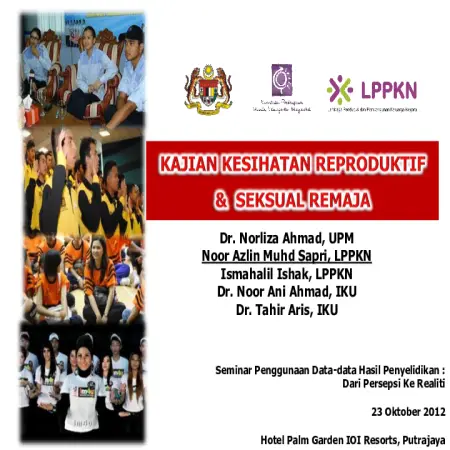TOPICS
Results for Topics : "Reproductive Health"
|
|
Youth and sex information: who they refer to?
Item Type: Scientific Poster
Editor:
Year: 00/07/2015
Abstract: Youths who involved in sexual behaviors can result in unintended health outcomes and put them at risk for HIV infection, sexuality transmitted infections (STIs), unintended pregnancy and very early childbearing. Factors associated to sexual risk behavior among youth are lack of sexual and reproductive health information and skills in negotiating sexual relationships, inaccessibility of youth-friendly sexual and reproductive health services and peer pressure (Kaestle et Al., 2005). Hence, it is clearly stated that our youths need access to protective information and skills before they become sexually active (Bleakley et al., 2010) Previous research shows significant results on various source of sexual and reproductive health information among youth such as friends, teachers, parents, peers, religious members and media (Gombachika et al.,2013; Kamrani et al., 2011; Bleaky et al., 2009) therefore, there is a need to know and do more address what kind of sources utilized by young people in getting information on sexual and reproductive health, in Malaysia specifically. The purpose of this study was to identify the individuals source of information related to sexual and reproductive health among Malaysia youth, as well as to examine the association of these sources with social demographic information.
|
|
|
|
|
|
Prevalence and risk factors of pregnancy loss in Malaysia
Item Type: Conference or Workshop Item
Editor:
Year: 00/00/2015
Abstract: The objective of this paper is to study the prevalence and risk factors of pregnancy loss in Malaysia. The risk of pregnancy loss is highest among Indian, followed by Malay and Chinese. The risk of pregnancy loss increases with level of education, age at 1st marriage and number of previous non-live births.
|
|
|
|
|
|
Faktor risiko dan pelindung terhadap kesihatan seksual dan reproduktif remaja di Semenanjung Malaysia
Item Type: Research Report
Editor:
Year: 00/00/2015
Abstract: In Malaysia, statistics from the National Registration Department (NRD) show that a total of 214,033 illegitimate children were born from 2004 to 2009. While statistics from the Royal Malaysia Police (RMP) show that 596 cases of baby abandonment were reported from 2005 to 2013. For the total number of rape crimes in among teenagers under the age of 18, PDRM statistics show an increase from 1,710 cases in 2006 to 2,658 cases in 2013. The increase in such cases shows that today's teenagers face the problem of moral decay and fragility of identity which is a concern of Malaysian society. Accordingly, knowledge of sexual and reproductive health can help adolescents avoid negative symptoms such as cases of extramarital pregnancies and social symptoms related to sexuality. The objective of this study was to (i). to study the prevalence of unhealthy sexual behavior among adolescents aged 13-24 years in peninsular Malaysia; (ii). identify risk factors related to adolescent sexual and reproductive health (ASRH); and (iii). identify protective factors related to ASRH. This study was implemented using two (2) main approaches, namely quantitative and qualitative methods. The design of the quantitative study was successfully conducted on 5,088 adolescents aged 13 to 24 years. The qualitative study involved a total of eight (8) Focus Group Discussions (FGD) conducted in eight (8) selected detention centers and shelter hostels located in several states in Peninsular Malaysia.
|
|
|
|
|
|
Risk and protective factors affecting youth sexual and reproductive health in Peninsular Malaysia
Item Type: Scientific Poster
Editor:
Year: 00/01/2014
Abstract: Over the last 10 years, youth sexual and reproductive health (SRH) had raised a lot of concern on the national agenda. This concern has been driven by increasing proportion of young people who had sex at early age, increasing prevalence of HIV/AIDS and STI particularly in Malaysia.
|
|
|
|
|
|
Risk and protective factors affecting adolescent youth sexual and reproductive health in Peninsular Malaysia
Item Type: Conference or Workshop Item
Editor:
Year: 00/00/2014
Abstract: This study shows that over the last 10 years, youth sexual and reproductive health (SRH) had raised a lot of concern on the national agenda. According to the statistics, age at first sexual intercourse to be as early as 9-10 years for both male and female adolescents (The Youth Sexuality Survey, 1996). The proportion of HIV infection due to sexual transmission is increasing from 18.8 % in 2000 to 55.5 % in 2011. About 26 % of newly infected cases of heterosexual transmission in 2011 are among teens and youth aged between 13 to 29 years. This study is to determine the prevalence of SRH behaviours of adolescent/youth and to identify risk and protective factors that influence adolescent/youth sexual reproductive health in Peninsular Malaysia.
|
|
|
|
|
|
Kajian kesedaran dan pengetahuan orang awam mengenai infertiliti
Item Type: Conference or Workshop Item
Editor:
Year: 00/00/2014
Abstract: The infertility rate in Malaysia is estimated around 10 to 15 %. World Health Organization has classified infertility as a disease that needs attention as early as possible. It is one of the factors that contribute to decreasing total fertility rate. Public misunderstanding regarding infertility may affect on how they handle this issue. People always take this issue lightly since it is not a life-threatening disease, unlike heart attack, diabetes and cancer. The Bertarelli Foundation Scientific Board (1999) had found that infertility awareness was still low in a few countries in Europe, such as Belgium, Italy, France, Germany, Sweden and United Kingdom. Knowledge on infertility is very crucial because it helps couples to prepare when they are having difficulty in conceiving. The objective of this study was to identify our local people awareness and knowledge on infertility issues as very few studies have been done in Malaysia.
|
|
|
|
|
|
Customer retention: a case study of LPPKN clinical services
Item Type: Conference or Workshop Item
Editor:
Year: 00/00/2014
Abstract: This is a descriptive study intended to identify the main factors which contribute to the customer retention among the “Clinical Clients” of National Population and Family Development Board or LPPKN. The study focused on three variables to check on the level of influence, affect and effect to the process of customer retention. Those variables are service branding, perceived value and service quality. The study also covered the impact and influence of the demographic element to the service branding, perceived value and service quality in the process of customer retention. This study was conducted at the LPPKN Clinics in Klang Valley and Seremban. Understanding and fulfilling the customers need will contribute to retaining existing customers and reduce the customer switching intentions. The research findings show there is a positive relationship between perceived value and service quality with customer retention. Nevertheless relationship between service branding and customer retention is not supported for the LPPKN clinical setting. Analysis on the demographic factor showed that, it has a significant influence in regard to service branding, perceived value, services quality and customer retention. The output of the study will be helpful to managers and marketers of the clinical service to understand the customer needs, priority and expectations. Furthermore the findings of the research will enable the managers and policy makers to take necessary actions in their marketing and operational planning to stay competitive and maintain a stable income for a long term. This study will also help LPPKN Clinics to improve service quality, increase number of clinical clients, facilitate the process of customer retention and in long term improve financial performance.
|
|
|
|
|
|
Kajian kesihatan reproduktif & seksual remaja
Item Type: Conference or Workshop Item
Editor:
Year: 00/00/2012
Abstract: The increase in reproductive and social health issues among adolescents has been hotly debated both nationally and internationally. Every day, Malaysians are presented with news on adolescent misconduct, especially those involving cases of abortion and out -of -wedlock pregnancies. Therefore, a specific study to look at the level of reproductive and sexual health of adolescents and the factors that influence it was conducted based on the results of the national level of adolescent health research. Methodology this cross -sectional study was conducted in 2010 using secondary data from the Adolescent Health Screening Form (BSSK/R/1/2008) which was filled by trainees of the National Service Training Program (NSTP) in 80 NSTP camps throughout the country. To achieve the objectives of the study, the analysis used is descriptive analysis, chi -square test and logistic regression using SPSS software. The parameters studied included socio-demographic characteristics (gender, age, ethnicity and level of education) and social characteristics (risky behavior, history of abuse, anti-social behavior, substance abuse, religion, and family relationships). While there are nine (9) SRH issues that were studied, namely masturbation, watching pornography, extramarital sex, multi -partner sex, STIs, homosexual tendencies, homosexual relationships, pregnancy and abortion. Results A total of 23,231 data were analyzed. Of these, a total of 22,750 respondents aged 18-24 years were screened for the purpose of study analysis. The results of the analysis showed that the issue of watching and reading pornographic material among adolescents recorded the highest percentage (39.5%) followed by masturbation (28.5%) and extramarital sex (6.5%). All socio -demographic factors studied had a significant relationship with extramarital sex, homosexual predisposition and abortion (p <0.05). Risk factors for extramarital sex are the age group of 20-24 years (OR = 2.710, SK95% 1.967, 3.759), risky behavior (OR = 30.495 SK95% 19.683, 47.427), involvement in substance abuse (OR = 12.33 SK95% 8,051, 18,891), anti-social (OR = 2,615 SK95% 2,206, 3,100) and ever abused (OR = 1,726 SK95% 1,389, 2,145). While the appreciation of religion is a protective factor for adolescents where the study found that adolescents who appreciate religion are twice as likely to have sex compared to adolescents who do not appreciate religion. There is no evidence to suggest that familial relationship variables influence adolescents to have sex. Conclusion overall it can be concluded that adolescent reproductive and sexual health issues need to be given serious attention. This is because the results of the study show that the trend of extramarital sex among adolescents which is a key indicator of the level of adolescent reproductive and sexual health issues has increased from 2.2% in 2004 (MPFS-4) to 6.5% in 2010. Therefore, multisectoral cooperation programs are needed to address this issue. The implementation of intervention programs should also be focused on high-risk adolescents such as having risky behaviors, anti-social and involved in cases of substance abuse. The planning and preparation of the program must also take into account the concepts and teachings of religion practiced in Malaysia through an approach that can be accepted by adolescents. Further studies need to be conducted more extensively taking into account other factors that have yet to be explored.
|
|
|
|
|
|
National experience in population matters: adolescents and youth
Item Type: Newsletter
Editor:
Year: 00/00/2012
Abstract: Adequate and accurate sexual and reproductive health information helps young people to make informed and responsible decisions. Howewer, cultural and religious sensitivities within the communities remain one of the major challenges in implementing reproductive health education for young people. Parents are still uncomfortable talking about reproductive health matters with their children ,leaving their children dependent upon information from their peers or other sources like the internet. The Government of Malaysia takes cognisance of the increasing importance of the sexual and reproductive health needs of adolescents and youth in Malaysia. Hence, the Government of Malaysia has put in place various policies and programmes to handle the sexual and reproductive health needs of the adolescents and youths. One of the main initiatives is the Healthy Programme without AIDS for Youth (PROSTAR). The Government of Malaysia also has established six youth-friendly adolescent centres known as kafe@TEEN to increase access to reproductive health information and services for young people aged 13 to 24 years.
|
|
|
|
|
|
Cytotoxicity and expression profiles of apoptosis gene related in human cervical cancer (HeLa) cell lines in response to Newcastle disease virus (NDV) strains AF2240 And V4-UPM
Item Type: Thesis
Editor:
Year: 01/01/2011
Abstract: In this study the cytotoxicity and expression profiles of apoptosis gene related in human cervical cancer (HeLa) cell lines in response to Newcastle disease virus (NDV) strains AF2240 and V4-UPM were studied. NDV is a strain of avian paramyxovirus. NDV has been classified into the order Mononegavirales, family Paramyxoviridae, subfamily Paramyxovirinae and genus Rubulavirus. NDV caused severe economic losses in the poultry industry worldwide. Several local strains of Newcastle disease virus were reported to induce cytolysis to the cancerous cell lines. Strain AF2240 is a heat resistant viscerotropic velogenic NDV and strain V4-UPM is a heat resistant lentogenic which has significant higher thermostabilities of infectivity and haemagglutination were reported cytolysis leukemic cells in vitro and has shown in vivo anti leukemic agents . In this study the cytotoxicity effects of strains of NDV AF2240 and V4-UPM towards HeLa cell were determined by using standard microtetrazolium assay (MTT). Cytotoxicity dose 50% (CD50) cells treated with different titre of NDV as haemagglutination units (HAU) as compared to the untreated cells was estimated at 72 hours post-infection. The CD50 values obtained were 0.95 HAU and 1.0 HAU for strains AF2240 and V4-UPM, respectively. No cytolytic effect was noted towards normal cells (3T3) was observed. Both strains were also observed to inhibit HeLa cell proliferation. Morphological observations also have been done under inverted light and fluorescence microscopes. Under the inverted light microscope, the HeLa cells treated with both strains showed apoptotic features such as cell shrinkage, cell blebbing and formation of apoptotic bodies. Morphological features of apoptosis were also observed by using the AO/PI staining method under the fluorescence microscope. The AO/PI staining demonstrated the occurrence of apoptosis which was characterised mainly by chromatin condensation, nuclear shrinkage and formation of apoptotic bodies. Evidently, both strains AF2240 and V4-UPM used in the study were found to induce cells towards apoptosis rather than necrosis. NDV strain AF2240 and strain V4-UPM was also caused genotoxic in HeLa cells after two hours treatment with CD10 and CD25 values by alkaline comet assay. Results showed that HeLa cells treated with NDV strains AF2240, V4-UPM and hydrogen peroxide gave different distribution of scores. The HeLa cells treated with hydrogen peroxide as a positive control gave more percentage at score 2, 3 and 4 for both cytotoxicity values compared to the HeLa cells treated with NDV for both strains. Observation in this study has proved the genotoxic potential of the NDV strains AF2240 and V4-UPM to induce DNA damage on HeLa cells as early as two hours following treatment at very low cytotoxicity dose (CD10 and CD25) values. Meanwhile, the cell cycle analyses of HeLa cells treated with local strains of NDV AF2240 or V4-UPM did not induce cell cycle arrest in any specific phase. Sub-G1 phase (apoptosis peak) was found in both treated cells with a very high percentage compared to untreated cells with a small percentage. The results indicate that, the percentages of apoptosis were significantly increased (p≤0.05) in the time-dependent manner in both NDV strains treated HeLa cells. The molecular mechanisms of apoptosis may depend on the NDV strain and cell type. Six apoptosis genes were selected in this study namely Casp8, TNF-α, Bcl2 and TRAIL which focused on extrinsic pathway of apoptosis, while the gene Bax was used as an indicator for intrinsic pathway triggered by cellular stress. Lastly Myc, oncogene was used as an indicator for cell growth. From this study, NDV strain AF2240 was identified as a highly induced death receptor pathway due to the upregulation of TNF gene and the downregulation of Bax gene. Whereas NDV strain V4-UPM triggered both pathways but through the extrinsic pathway due to the very high expression of the TNF gene. The TNF gene was highly expressed due to its location and function as a stimulator of the death receptor pathway. The Casp8 gene was activated and expressed in order to enter the execution-phase of cell death. The Bcl-2 gene was continuously observed because of its function as an apoptosis regulator. Surprisingly, no expression was detected by the TRAIL gene. NDV strain AF2240 was more effective than NDV strain V4-UPM as an apoptosis inducer. These gene expression results showed that the apoptosis occurred and lead to cell death.
|
|
|
|





